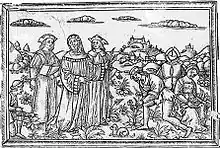Matthaeus Silvaticus
Matthaeus Silvaticus or Mattheus Sylvaticus (c. 1280 – c. 1342) was a medieval Latin medical writer and botanist.

Life
Silvaticus was born in northern Italy, probably Mantua.[1] He was a student and teacher in botany and medicine at the School of Salerno in southern Italy.
Encyclopedia
He is noted for writing a 650-page encyclopedia about medicating agents (a pharmacopoeia) which he completed about year 1317 under the Latin title Pandectarum Medicinae or Pandectae Medicinae (English: Encyclopedia of Medicines). Most of the medicating agents were botanicals ("herbal medicines"). The presentation is in alphabetical order. The bulk of the manuscript is compiled from earlier medicine books, including books by Dioscorides, Avicenna, Serapion the Younger, and Simon of Genoa.[2]
As an indication of its popularity in late medieval Europe, the Pandectarum Medicinae was printed in at least eleven editions in various countries between the invention of the printing press and 1500.[3]
Medical school
The medical school in Salerno was influenced by Arabic-to-Latin translations of Arabic medical literature. As one indication of Arabic influence, 233 of 487 plant names that Matthaeus used were Latinizations of Arabic plant names.[4] Many of those Latinized Arabic names had little circulation in Latin. Native Latin names existed for some of them, in which case Matthaeus also presents the native Latin name as well. In some cases he prefers to give primary status to the Arabic name in preference to the classical Latin name. In other cases he gives primary status to the Latin name and just mentions what the Arabic name is.
European pharmacology
The Pandectarum Medicinae is an encyclopedia with almost no original thinking. It has considerable value to historians as a document reflecting the state of pharmacology and medicine in Europe in the late medieval era. The method of presentation in Pandectarum Medicinae is that a medicinal substance is named together with very brief identifying information and then follows several lengthier summaries or quotations from several well-known medical authorities about the substance's properties and uses. The medical authorities are either (A) the particular ancient Greek medical writers that were widely read by the medieval Arabs (particularly Diosorides and Galen) or else (B) Arabic medical writers (particularly Serapion the Younger and Avicenna).
Simon of Genoa
Part of Matthaeus's encyclopedia was taken from a shorter work by Simon of Genoa (aka Simon Januensis) entitled Synonyma Medicinae, which was written a few decades earlier and which is a dictionary of medicines rather than an encyclopedia.[5]
References
- Dictionnaire historique de la médecine ancienne et moderne, by N.F.J. Eloy (year 1778).
- "The Encyclopedia of Medicaments - Pandectarum Medicinae". World Digital Library. May 11, 2013. Retrieved 2014-03-01.
- Pandectarum Medicinae at http://www.interzone.com/~cheung/SUM.dir/med43.html. A number of 15th century editions of the Pandectarum are online at Digitale-Sammlungen.de.
- Matteo Silvatico @ SummaGallicana.it (in Italian language).
- A late-15th-century edition of Simon of Genoa's Synonyma Medicinae is online at Google Books (in Latin). A 19th-century publication of a 15th-century Latin medical botany dictionary called the Alphita contains, in its 19th-century footnotes, many cross-references to Mattheus Silvaticus and Simon Januensis. It is downloadable at Alphita.
External links
- A short biography of Mattheus Silvaticus together with a description of his Pandectarum Medicinae is at SummaGallicana.it (in Italian language)
- Different editions of the Opus Pandectarum (aka Liber Pandectae) as printed in Latin in the late 15th century are online at Digitale-Sammlungen.de (year 1498), Digitale-Sammlungen.de (year 1488), Gallica.BNF.fr (year 1480).